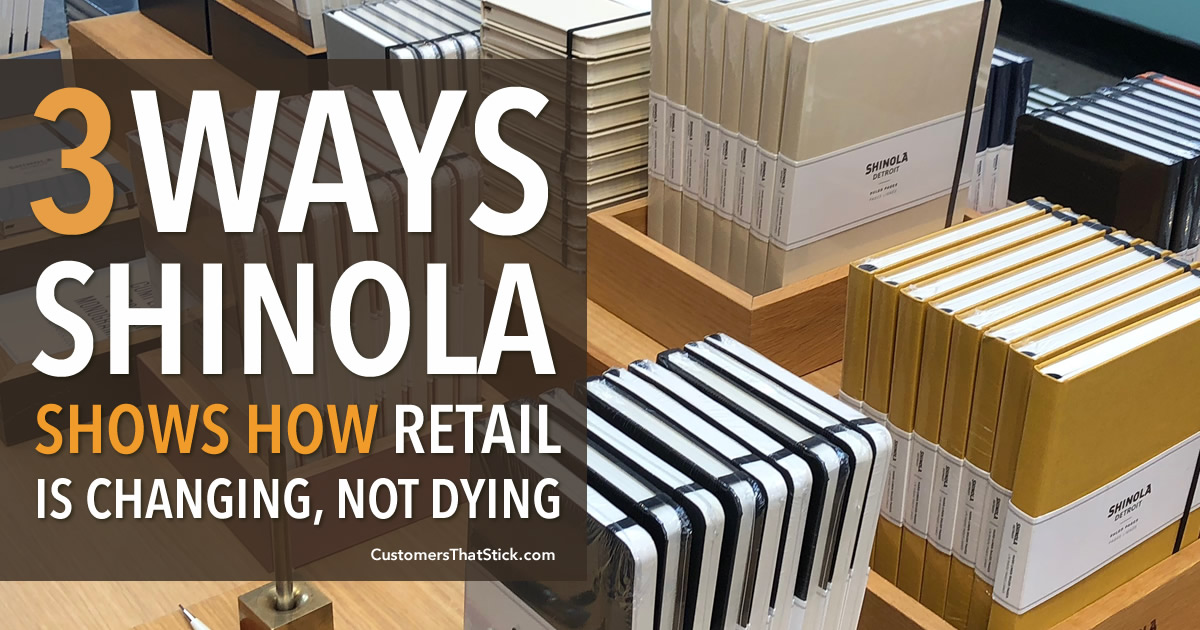
Each year, we see increasingly more retail establishments fail. However, retail is not dying; in fact, it has a bright future. It just looks different than it did five years ago.
On a trip to Detroit last week, a friend of mine who lives in the area took me to the original Shinola store. I had only recently become aware of Shinola when I purchased one of their watches via a third party a few months prior.
The more I dug into the brand and its story of Detroit rebirth, the more I was fascinated by what the company is doing and how they are creating successful retail experiences.
In Shinola’s approach are a number of lessons for how retail is changing but not dying.
Below are three strategies used by Shinola. None of the below are rules; retailers will innovate and succeed without the first two strategies for sure. However, these trends will likely be heavily represented in the coming retail future.
Retail has a bright future; it just looks different than it did five years ago.
One of the areas where traditional retail is being most negatively impacted by changing consumer preferences and behaviors is low-to-moderate margin, large footprint models.
Traditional department stores, particularly on the low and middle end, have been hammered for a while. Other than the mass merchandisers, such as Wal-Mart and Target, that have successfully dominated the low-margin market, many others following the low-margin, large-footprint model, such as K-Mart and Sears, are struggling or failing.
Smaller footprints have two advantages that are indicative of the future of retail: they help lower fixed costs and they help facilitate more intimate and personal experiences.
Combining high margins with lower fixed costs can help compensate for the cost differences between retail and online.
One of the interesting parts about my visit to the Shinola store was just how much staff was available and how friendly and well-trained they seemed.
Of course, the staffing might have been a fluke of timing, in that the store seemed overstaffed for the amount of volume in the store at the time. Also, my experience was in one store, and they have many.
Regardless, in my personal experience on that day, I was approached by multiple sales reps during my visit, all of whom were friendly and wanted to make sure I was taken care of.
When I finally did work with an associate to make a purchase, she was knowledgeable, helpful, and even personalized the experience further by wishing my friend’s son luck with his hockey game that afternoon.
In short, the associate was available, and she was trained.
One of the amazing things about the Shinola store was that I was able to customize a gift, on the spot, in about a minute.
My wife likes little linen notebooks (like the one in the picture above), so I thought I would get her one as a my husband went to Detroit in February and all I got was to stay in sunny Florida and this stinking notebook gift.
As I needed to get to the airport, we were on a bit of a clock, so I assumed I did not have time to get the notebook monogrammed, a customization service Shinola offers. However, I asked the associate just in case.
“How long would it take to get my wife’s initials on the book?”
“About 38 seconds,” she replied with a smile.
The amazing thing was, she wasn’t exaggerating by much. We had the notebook monogrammed with my wife’s initials, and I had a personalized gift to bring home, all within about a minute.
On-demand, personalization and customization are a big part of the new retail resurgence.
While retail may not be dying, the transition from its past to its future will certainly be painful. Shifting from larger footprints to smaller footprints, as well as the disruption in many industries that comes from the shift, will affect a great many lives.
Will organizations with large footprints continue to arrive and thrive? Of course, particularly if they focus on experience first. Indoor trampoline concepts are a good example of this.
Will the above three attribute guarantee that Shinola succeeds? No. Consumers could tire of the brand; bad decisions could be made at headquarters. Possessing certain attributes of success does not guarantee achieving success.
Possessing certain attributes of success does not guarantee achieving success.
Also, other strategies besides the three above will be important in the retail future, such as blending online with in-store experiences, using data for deep personalization, and a host of others.
Finding the secret sauce for each industry and business model will not be easy, but the good news is that it is not too late.
Retail has a bright future because we humans still crave interaction and experiences with other humans. We still seek emotional moments and connection that just can’t be replaced by two-day shipping.
Shinola’s path is not the only path in the new retail, but within its experience are lessons for other organizations who want to connect better with their customers in a more face-to-face, experiential way.
Comments are closed.
© 2011-2025 CTS Service Solutions, LLC.
All rights reserved.
Legal Information | Privacy Policy
How to Cite this Site
(Hockey not hickey)
Thank you! It is corrected.
You said the associate wish your friend’s son well on his “hickey” game. Oh, the things that young people engage in these days.
I’m not sure what young people do, but it’s obvious middle-aged people (i.e. me) do not engage in proofreading!
Thanks for the heads up James! It is updated.